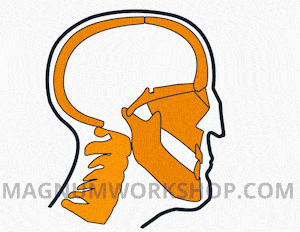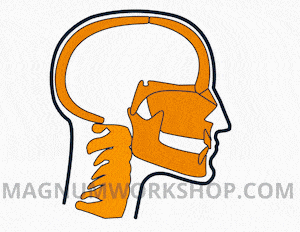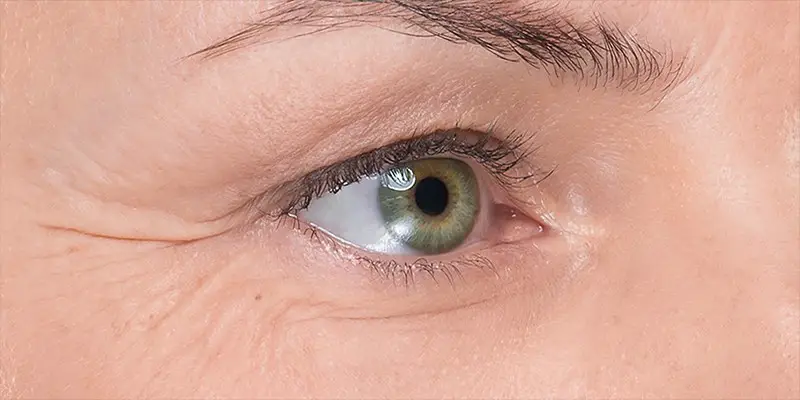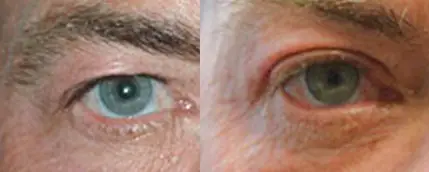
Deep-set eyes are considered attractive. If you have small looking eyes that appear to reside further back in your skull, you have deep-set eyes. Deep-set eyes create the illusion of a protruding brow ridge.
Proper craniofacial development and facial upswing cause deep-set eyes. Acromegaly, Sanjad-Sakati Syndrome, SHORT Syndrome, and aging can also cause deep-set eyes.
Consider one of our custom facial reports if you’re interested in an in-depth analysis of your eye area. Also, our premium and advanced reports analyze the forward craniofacial growth of your face with a suite of measurements.
Forward Grown vs. Recessed Maxilla
How the maxilla supports the eyes affects how the eyes will look. Forward facial growth correlates to a beautiful face. A forward grown maxilla will create nicely-shaped deep-set eyes. If well positioned, the maxilla will support the orbital bone and all the soft tissues surrounding it. The eyes will be symmetrical, have a positive canthal tilt, and the cheekbones beautifully defined with a well-positioned maxilla.
Here’s an animation of what happens to the facial bones when going from poor to good development:

Notice how the posture of the head changes as well. With proper facial development and deep-set eyes, you are tilting your head downwards, and so less of your upper eyelid is exposed.
If the maxilla pushes forward and the cheekbones (zygomatic bones) go outward, you have a forward grown maxilla. Dr. Mew proposes that the tongue expands the sphenoid and the maxilla, which can only mewing can achieve. For more info on mewing, check out our guide.

On the other hand, a recessed maxilla is why you have a narrow smile, sunken cheek, droopy-eyed look, and a long face. A recessed maxilla will cause the development of eye bags and dark circles around the eyes. As you age, your face will develop in this manner.

The only way to counteract this is with mewing.
If your maxilla is not well developed, there are two effective ways to improve it:
- Mewing – a technique that helps improve facial features and appearance through proper tongue posture. Mewing is the best method to get attractive eyes. By keeping the tongue in the right position, there will be a significant improvement in the maxilla. A forward grown maxilla is the only thing that can swing your face up and decrease your upper eyelid exposure. There is no surgery you can get to have more deep-set eyes.
- Orthodontic headgear – these devices apply high forces to the upper jaw to remodel the maxilla and force it to move to a better position. This technique is more effective in children because of bone malleability but also works for adults.
Deep Set Eyes: The Three Medical Conditions
There are three medical conditions linked to the onset of deep-set eyes. They are:
Acromegaly
The leading cause of this disorder is the pituitary gland’s overproduction of growth hormone during puberty. With an excessive supply of growth hormone, the bones of the face, feet, and hands become bigger. If you have acromegaly, your facial bones grow prominent, causing the appearance of having deep-set eyes. A marked symptom is prominent brow and jawbones.
Surgery, medication, and radiation therapy can treat acromegaly. Surgery will remove the tumor in the pituitary gland. A pituitary tumor is the cause of the excessive growth hormone production in 99% of patients with acromegaly. (Banerji et al. 2016)
Other patients with acromegaly may be treated with medications to help shrink the pituitary gland tumor. The three known drugs for acromegaly are somatostatin analogs (SSAs), growth hormone receptor antagonists (GHRAs), and dopamine agonists.
If surgery is not an option, doctors will recommend radiation therapy or radiotherapy, which targets the tumor to decrease its size gradually.
In a clinical case report published by The Pan African Medical Journal, experts observed that rapid oral cavity changes are frequent and sometimes dramatic. Prosthetic management of patients with acromegaly requires stabilization of the disease as bone changes will prevent prostheses’ effectiveness over time. (Bekri, et al. 2019)

Sanjad-Sakati Syndrome
This disorder is a recessive genetic condition that causes impaired growth. You will also notice deformed facial features like deep-set eyes, enlarged ears, narrow face, thin upper lip, and a beaked nose. These are clear indicators of this syndrome. You can treat some of the symptoms with vitamin D and growth hormone supplements.
Rafique et al. (2010) mentioned that Sanjad-Sakati Syndrome first appeared in 1998 in the Kingdom of Saudi Arabia. Those affected by this syndrome showed its typical features such as a long narrow face, deep-set small eyes, beaked nose, large floppy ears, and micrognathia.
Arabi et al. (2011) obtained clinical findings from 4 patients with this syndrome that showed that deep-set eyes and a prominent forehead were present in all 4 cases.
SHORT Syndrome
SHORT syndrome is a rare ailment. It delays growth in different parts of your body and is common in both adults and children. You will notice a protruded forehead and the onset of deep-set eyes if you have this. You will see signs of early aging. It is also common to observe deformities in the teeth. For treatment, a team of medical specialists will handle your case.

Aging and Deep Set Eyes
Getting older takes a toll on the different parts of your face. The first thing that usually shows signs of aging is the eyes. The eyes can appear as eye bags or bulges. Your eyes will start to develop dark eye circles, usually associated with not having enough sleep.
Periorbital fat and skin will droop over your eye. This skin sagging then creates the illusion of deep-set eyes, but in some instances, it’s bad enough to impair your vision. When this happens, it’s one of the few cases where your health insurance will pay for plastic surgery (blepharoplasty) to fix the issue.

You will also notice your brows shifting downward. Eyelid sagging will usually be seen under the lower eyelids and at the lateral corners of the upper eyelids. You will see wrinkles on the edge of the eye (crow’s feet). As you grow old, your skin loses collagen and elasticity, which manifests as more wrinkles.
For more info on how the skull bones change with age, and impact your facial aesthetics, check out our video on the topic:
Deep Set Eyes and the Maxilla
The maxilla is the bone that forms the central portion of the face. It is the most significant bone of the midface. Fused in the center of the skull, beneath the nose, in the intermaxillary suture are the irregularly shaped bones that make up the maxilla’s right and left halves. It has a significant role in facial architecture, separating the nasal and oral cavities, forming the upper jaw, and containing the maxillary sinus.

The maxilla is a major facial bone and is part of the following skull structures:
- The upper jawbone
- The lower part of the eye sockets
- The smaller parts and sides of the sinus and nasal cavities
Some of the several primary functions of the maxilla include:
- Holding the tooth roots
- Forming of the nasal aperture and floor, most of the hard palate, and the orbits’ floors. (Anderson et al. 2017)
Mewing and facial forward growth are key for an attractive eye area. For more info on the maxilla, check out this Looks Theory episode:
Remodeling the Maxilla Through Surgery
In some cases, maxillary growth correction using mewing or orthodontic headgear may take years before results manifest. Some people may want to opt for a surgical approach to correct the bone shape. Two of the surgeries to remodel the maxilla are:
- Surgically Assisted Rapid Palatal Expansion (SARPE) – this procedure consists of breaking the palate in half. A rapid palate expander will cut the palate in half. This procedure will require wearing of braces after the operation. It might improve your cheekbones, but it won’t necessarily create more eye support.
- Miniscrew-Assisted Rapid Palatal Expander (MARPE) – this procedure consists of placing screws to the mouth’s roof. The device then sloly splits the maxilla in half. Because the MSE doesn’t split the maxilla surgically and relies on external forces, the maxilla remodels naturally. MSE is the most popular type of MARPE.
Again, there is no surgery to get more deep-set eyes. Only mewing, orthodontic headgear, and proper craniofacial development can accomplish this.
However, you can get an epicanthoplasty to correct the Mongolian fold common in East Asian ethnicities. This surgery will help reduce the appearance of your deep-set eyes.


